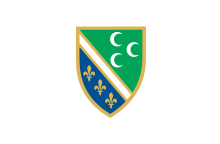Bosniaks of Montenegro
 Flag of Bosniak minority in Montenegro | |
| Total population | |
|---|---|
| 53,605 (8.6%) (2011 census)[1] | |
| Regions with significant populations | |
| Rožaje Municipality (83.91%) Petnjica Municipality (83.02%) Plav Municipality (51.90%) Gusinje Municipality(42.64%) Bijelo Polje Municipality (27.34%) Berane Municipality (17.72%) Tuzi Municipality (9.23%) | |
| Languages | |
| Bosnian | |
| Religion | |
| Sunni Islam | |
| Related ethnic groups | |
| Bosniaks, Albanian Muslims and other South Slavs |
Bosniaks are an ethnic group in Montenegro, first introduced in the 2003 census. According to the last census from 2011, the total number of Bosniaks in Montenegro was 53,605 or 8.6% of the population. Bosniaks are the third largest ethnic group in the country, after Montenegrins and Serbs.
Demographics[]


Bosniaks primarily live in northern Montenegro, in the area called Sandžak and they form the majority of the population in four municipalities: Rožaje (83.91%), Petnjica (83.02%), Plav (56%) and Gusinje (42.64%).
History[]
Two thirds of Sandžak Bosniaks trace their ancestry to the regions of Montenegro proper, which they started departing first in 1687, after Ottoman Empire lost Boka Kotorska. The trend continued in Old Montenegro after 1711 with the extermination of converts to Islam ("istraga poturica"). Another contributing factor that spurred migration to Sandžak from the Old Montenegro was the fact that the old Orthodox population of Sandžak moved towards Serbia and Habsburg Monarchy (Vojvodina) in two waves, first after 1687, and then, after 1740, basically leaving Sandžak depopulated. [2]
The last segment of Sandžak Bosniaks arrived from several other places. There was a continuous intermingling with the members of the local Turkish administration and military.[3] Some of Bosniaks came from Slavonia after 1687, when Turkey lost all the lands north of Sava in the Austro-Turkish war. Many more came from Herzegovina in the post-1876 period, after the Herzegovina Rebellion staged by the Serbs against Austro-Hungary and their Muslim subjects. Another wave followed immediately thereafter from both Bosnia and Herzegovina, as the Treaty of Berlin placed the Vilayet of Bosnia under the effective control of Austria-Hungary in 1878. The last wave from Bosnia followed in 1908, when Austria-Hungary officially annexed Bosnia, thereby cutting off all direct ties of Bosnian Muslims to the Sublime Porte, their effective protector. Today, Bosniaks are a large minority in Montenegro, with over 50,000 Bosniaks living in Montenegro.[4]
Politics[]
- The main political party of Bosniaks is the Bosniak Party (BS), led by Rafet Husović. The party currently has two seats in Parliament of Montenegro.
- Another one is Justice and Reconciliation Party in Montenegro (SPP u Crnoj Gori), led by Hazbija Kalač.
Most Bosniaks of Montenegro were in favor of Montenegrin independence when the independence referendum was held in 2006.
Dialect[]
The Slavic dialect of Gusinje and Plav shows very high structural influence from Albanian. Its uniqueness in terms of language contact between Albanian and Slavic is explained by the fact that most Slavic-speakers there are of Albanian origin.[5]
Religion[]
Today, the majority of Bosniaks are predominantly Sunni Muslim and adhere to the Hanafi school of thought, or law, the largest and oldest school of Islamic law in jurisprudence within Sunni Islam.
Notable people[]
|
|
|
See also[]
References[]
- ^ Montenegro#Demographics
- ^ {{Citation needed|date=November 2021|reason=no reliable sources cited}}
- ^ {{Citation needed|date=November 2021|reason=no reliable sources cited}}
- ^ {{Citation needed|date=November 2021|reason=no reliable sources cited}}
- ^ Matthew C., Curtis (2012). Slavic-Albanian Language Contact, Convergence, and Coexistence. The Ohio State University. p. 140.
External links[]
- Bosniaks of Montenegro
- Bosniak diaspora
- Ethnic groups in Montenegro
- Muslim communities in Europe
